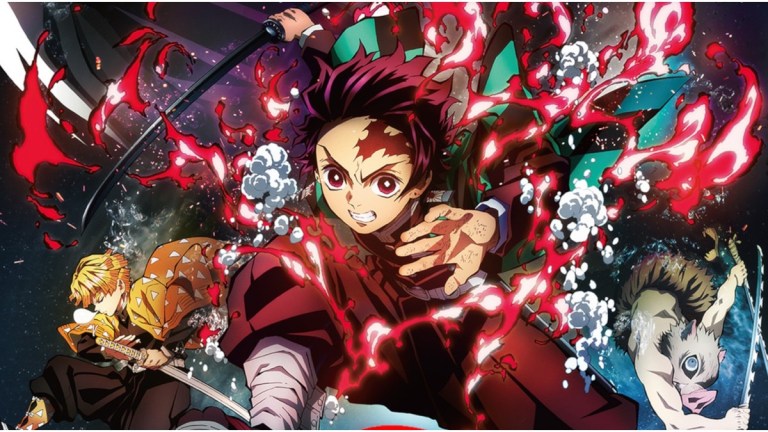Demon Slayer Review: Netflix Anime Reinvents Classic Action Tropes
Demon Slayer: Kimetsu no Yaiba uses classical action archetypes to craft an addictive story about the bonds of family and good versus evil.

This Demon Slayer review contains no spoilers.
There are a lot of anime about the slaying of demons. Almost too many, in fact. If someone was supposed to make an anime, but then forgot and had to quickly rush something together at the last minute, they’d make it about demon slaying. At this point it’s a little exhausting whenever a new demon-slaying anime gets announced, but it’s for this very reason that the series that work are especially effective.
Koyoharu Gotouge’s Demon Slayer: Kimetsu no Yaiba doesn’t just touch on familiar storylines and ideas, even its title is bland and vague. However, Demon Slayer turns out to be one of the most enjoyable new anime to come out in the past few years and it’s a very exciting addition to Netflix’s growing anime library.
Demon Slayer begins in an explosive manner that turns the relatively timid Tanjiro Kamado into a vengeful warrior after he experiences the worst kind of trial by fire. Demons attack Tanjiro’s family and turn his sister, Nezuko, into one of their kind. The newly orphaned Tanjiro meets a Demon Slayer and becomes committed to avenging his family’s death, taking down any evil creatures that he encounters, and cure his sister of her unfortunate fate.
Tanjiro’s journey aligns himself with Zenitsu and Inosuke, two fellow budding fighters, and the lot experiences significant growth and challenging hardships the further they go. There’s also a very natural chemistry and sense of humor between this core group of characters, which helps balance out the anime’s more melodramatic moments.
Tanjiro and his group go through the usual hurdles of training and battles as they learn and refine powerful abilities. Demon Slayer doesn’t cram too much into its first season and the majority of these episodes get a chance to breathe where the characters can properly express themselves and not be rushing from one battle to the next.
Many of the battles against demons are spread across multiple episodes rather than a need to resolve each fight by the time that the credits roll. Demon Slayer is more concerned with characterization, for both its heroes and demons, so battles can mean more when they do happen. This means that some episodes are less productive than others, but it helps the series find its voice more quickly as a result.
It’s of course important to have protagonists that feel real and not just come across as anime stereotypes, but Demon Slayer especially excels with how it humanizes its villains. The episodes devote lots of time to who these demons were before their corruption, how they got like this, and what they sacrificed as a result. It’s a creative way to unify the heroes and the villains. This level of empathy doesn’t stop Tanjiro in his mission to eliminate these monsters, but it sometimes gives him pause as he considers how his sister is now in the same situation.
Demon Slayer wants both Tanjiro and the audience to consider how some of these demons are just as innocent or in need of redemption as Nezuko. It’s a fascinating wrinkle that adds a deep vein of melancholy and pain to each of Tanjiro’s victories. So many anime of this nature celebrate the heroes’ successes over beastly creatures, which makes Demon Slayer’s contemplative attitude all the more gripping. Tanjiro and company aren’t interested in bragging rights or even that focused on becoming the strongest Demon Slayers. They merely want to achieve their personal goals and move on with their lives. It’s a refreshing perspective that helps ground these characters during their more exaggerated moments or the times that action overwhelms story.
Demon Slayer’s attention to world building is another reason why the anime works as well as it does. The story establishes powerful groups of characters in both the villainous Twelve Demon Moons as well as the altruistic Demon Slayer Corps and the Hashira. It can be common for the villains in an anime to have a team of enemies that they slowly rotate through, yet this feels different in Demon Slayer even though it’s still technically true. The season offers up just enough information on the Twelve Demon Moons and their leader, Muzan Kibutsuji, so that they’re compelling and terrifying, but far from overexposed. Muzan in particular is a villain that actually feels enigmatic and unstable. He’s far from the caricature that anime villains can often devolve into.
Demon Slayer leaves the audience wanting more in basically every category rather than overstay their welcome. It’s a smart approach for a series’ first season, but the next batch of episodes will need to pick up the pace and accelerate this strategy. This attitude is present right up to the season’s conclusion, which is satisfying, but does feel abrupt to some extent. It doesn’t go out on a major cliffhanger or triumphant battle. It’s a more muted finish, likely because the anime knew that it’d get its Mugen Train feature film to function as a more substantial ending. It’s appreciated to not get a season finale that’s manipulative of its audience, but at the same time it wouldn’t have hurt to turn up the tension a little more.
There’s a dense story about the conflict between good and evil that’s important to Demon Slayer, but it’s also entirely possible to just enjoy this series because of its exciting and gorgeous fight sequences. The animation studio, ufotable, truly makes every frame of the anime pop. The thick lines used for character designs are a little awkward at first, but it helps Demon Slayer develop its precise and vibrant style. The battles are aesthetic masterpieces and the many different demons all incorporate unique abilities that inject a healthy dose of horror into these action scenes. All of Tanjiro’s victories have a greater impact thanks to how they’re painstakingly animated. The same level of care is applied to Demon Slayer’s dub and the performances all make sure to match the level of energy that’s present in the scenes.
As much as Demon Slayer is a delight, it’s also not without its faults. Nezuko is a largely static character that doesn’t really get a chance to do much until the later half of the season. Similarly, Inosuke and Zenitsu are wonderful, but they disappear for certain stretches of time and can often feel inconsequential. They’re still characters that work more often than they don’t and they both get big moments where they demonstrate intense growth and power. Demon Slayer can sometimes fall into a bit of a predictable pattern at times and if the characters aren’t working for you then the slower pacing will definitely feel frustrating. There’s certainly an urgency in Tanjiro’s quest, but the anime doesn’t mind waiting for larger events to transpire and for the plot to move forward on its own schedule.
The anime does impressive work with how it reinvigorates an overdone genre and narrative with a fresh and exciting approach. Demon Slayer creates a world that’s entertaining, easy to get lost in, and led by a cast of characters that are increasingly lovable. It feels like Demon Slayer is still in the infancy of its story, but it’s not often that a series comes out of the gate with such confidence and style.
Demon Slayer: Kimetsu no Yaiba is one of the biggest anime to come out in the past few years and it’s a series that has something for everyone to enjoy, whether it’s the hyperbolic fight sequences, the hordes of disturbing demons, or the breathtaking animation that brings the demon slaying to life. Demon Slayer is not going anywhere and it’s now the perfect time to jump on board.
Demon Slayer: Kimetsu no Yaiba is available to stream on Netflix now.
Subscribe to Den of Geek magazine for FREE right here!


